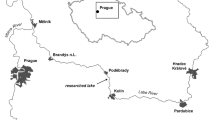Abstract
Water and sediment samples were collected from 18 sampling stations in Wadi Gaza for two successive years in order to: (1) Establish a baseline condition of the geochemistry of surface water and sediments; (2) assess the impact of seasonal variation on distribution of heavy metals and major ions; and (3) identify possible natural and anthropogenic sources of pollution. The heavy metal concentrations in the sediments of the lake (downstream) were higher than those of the eastern eight stations(upstream) where the water was shallower. Shallower areas showed greater temporal variation than deeper areas. Several elements (P, Fe, Mn and As) showed the greatest temporal variability. For example, in the winter rainy season these elements decreased 2–10 times compared to their values in summer. Moreover, Ca, Na, Cl, PO4, and NO3 decreased3, 3, 5, 2, 4 times, respectively. Some of the trace metals were more abundant in these waters compared to the domestic wastewaters of the study area. The averages of Cd and Co were 6 and 43 μg/l, respectively and they were 50 times higher than the domestic wastewater results. The discharge of olive oil mill wastewater was recorded in the Ca, Na, Mg, K and P concentrations in sediments of one of the sampling stations.
Similar content being viewed by others
References
B.J. Alloway D.C. Ayres (1997) Chemical Principles of Environmental Pollution Chapman & Hall London, UK
InstitutionalAuthorNameAPHA. American Public Health Association (1995) Standard Methods for examination of water and wastewater EditionNumber19 Water Environment federation, American Water Works Association (AWWA), Water Pollution Control Federation Washington, DC, USA
P. Avila-Perez M. Balcazar G. Zarazua-Ortega I. Barcelo-Quintal C. Diaz- Delgado (1999) ArticleTitleHeavy metal concentrations in water and bottom sediment of Mexican reservoir Sci. Total Environ. 234 185–196 Occurrence Handle10.1016/S0048-9697(99)00258-2 Occurrence Handle10507157
H.J.M. Bowen (1979) Environmental Chemistry of the Elements Academic Press London, UK 333
CAMP,Coastal Aquifer Management Program. 2000. Water Quality Baseline Survey- Final Report. GazaPalestinepp. 54.
A.K. Cheburkin W. Shotyk (1996) ArticleTitleAn Energy-dispersive Miniprobe Multielement Analyzer (EMMA) for direct analysis of Pb and other trace elements in peats Fresenius J. Anal. Chem. 354 688–691
DINDeutsche Industrie Norm. 1997. Sediment Reference Standards (RS1, 2, 3). BeuthBerlin.
DIN. 1989. Bestimmung adsorbierbarer organisch gebundener Halogene (AOX) DIN 38414 S18 Deutsche Einheitsverfahren zur Wasser-, Abwasser- und Schlammuntersuchung Schlamm und Sedimente (Gruppe S). Beuth Verlag, Berlin.
E.Y. Haworth J.W.G. Lund (1984) Lake Sediments and Environmental History Minnesota University Press Minneapolis, USA 411
G.C. Holdren D.E. Armstrong (1980) ArticleTitleFactors affecting phosphorus release from intact lake sediment cores Environ. Sci. Technol. 9 405–407
J. Isaac B. Shalan F. Qumseh M. Ewaiwi A. Halayka Y. Abu Asa‘ad N. Katoosh (1997) Palestinian Environmental Encyclopedia, Vol. 1, Environmental Features of Palestine, Chapter 6 Applied Research Institute of Jerusalem Bethlehem, Palestine
P. Kelderman (1985) Nutrient Dynamics in the Sediment of Lake Grevelingen (SW Netherlands) Delft University Press DelftThe Netherlands 81
P. Kelderman (1996) Water Chemistry and Biology-Lecture notes HH277/96/1 IHE-Delft. Delft The Netherlands 54
P. Kelderman W.M.E. Drossaert Z. Min L.S. Galione L.C. Okonkwo A. Clarisse (2000) ArticleTitlePollution assessment of the canal sediments in the city of DelftThe Netherlands Water res; J. Int. Assoc. Water Qual. 34 936–944
J.I. Lu C.S. Li W.H. Wang A. Peng (1983) Chemical behavior of mercury in Ji Yun River Proceedings of the Heavy Metals in the Environment CEP Consultants LtdEdinburgh Heidelberg 780–83
MEnAMinistry of Environmental Affairs. 1999. Palestinian Environmental Strategy-Main ReportOctober 1999. GazaPalestine.
MEnAMinistry of Environmental Affairs. 2000. Palestinian Environmental Action Plan-October. GazaPalestine.
MEnAMinistry of Environmental Affairs. 2002. Conservation the Wetland and Biodiversity of Wadi Gaza. GazaPalestine.
G. Müller M. Gastner (1971) ArticleTitleThe carbonate bomba simple device for the determination of carbonate content in the sediments, soils and other materials National J. Miner. 10 466–469
InstitutionalAuthorNameNIST (1991) Standard Reference Material ProgramTrace Elements in Water 1643c, National Institute of Standards and Technology National Institute of Standards and Technology Washington, DC.
InstitutionalAuthorNameNIST (1994) Standard Reference Material ProgramTrace Elements in Water 1643d National Institute of Standards and Technology Washington, DC
S.W. Nixon J.R. Kelly B.N. Furnas C.A. Oviatt S.S. Hale (1980) Phosphorus regeneration and metabolism of coastal marine bottom communities University of South Carolina Press ColumbiaUSA 219–242
InstitutionalAuthorNameOka-Elbe Project. (2000) Heavy Metals and Organic Pollutants in Oka River Sediments-Final Report Institute of Environmental Geochemistry University of Heidelberg, Germany
PCBS, Palestinian Central Bureau of Statistics. 2000. Population, Housing and Establishment Census 1997. RamallahPalestine.
B. Rippey (1977) The behavior of phosphorus and silicon in undisturbed cores of Lough Neagh sediments H.L. Golterman (Eds) Interactions Between Sediments and Fresh Water Junk The Hague, The Netherlands 348–353
B. Shomar A. Yahya G. Müller S. Askar R. Sansour (2003) ArticleTitleFluorides in groundwatersoil and tea and the occurrence of dental fluorosis among school children of the Gaza Strip J. Water Health 2 23–36
M.A.L. Silva C.E. Rezende (2002) ArticleTitleBehavior of selected micro and trace elements and organic matter in sediments of freshwater system in south-east Brazil Sci. Total Environ. 292 121–128 Occurrence Handle10.1016/S0048-9697(02)00034-7 Occurrence Handle12108440
Y. Song G. Müller (1999) Sediment–Water Interactions in Anoxic Freshwater Sediments, Lecture Notes in Earth Sciences Springer Heidelberg, Germany
InstitutionalAuthorNameSPS (2002) Quality Control Material, SPS-WW2, Wastewater Level 2, Batch no. 106 Spectrapure Standards AS Oslo, Norway
K. Turekian K.H. Wedepohl (1961) ArticleTitleDistribution of elements in some major units of the earth's crust Bull. Geol. Soc. Am. 72 175–192
Zoarob Z. 1997. Hazardous Waste Management in the Gaza Strip. MSc thesis-DEW5, IHE. DelftThe Netherlands, pp. 86.
Author information
Authors and Affiliations
Corresponding author
Rights and permissions
About this article
Cite this article
Shomar, B.H., Müller, G. & Yahya, A. Seasonal Variations of Chemical Composition of Water and Bottom Sediments in the Wetland of Wadi Gaza, Gaza Strip. Wetlands Ecol Manage 13, 419–431 (2005). https://doi.org/10.1007/s11273-004-0412-3
Received:
Accepted:
Issue Date:
DOI: https://doi.org/10.1007/s11273-004-0412-3




